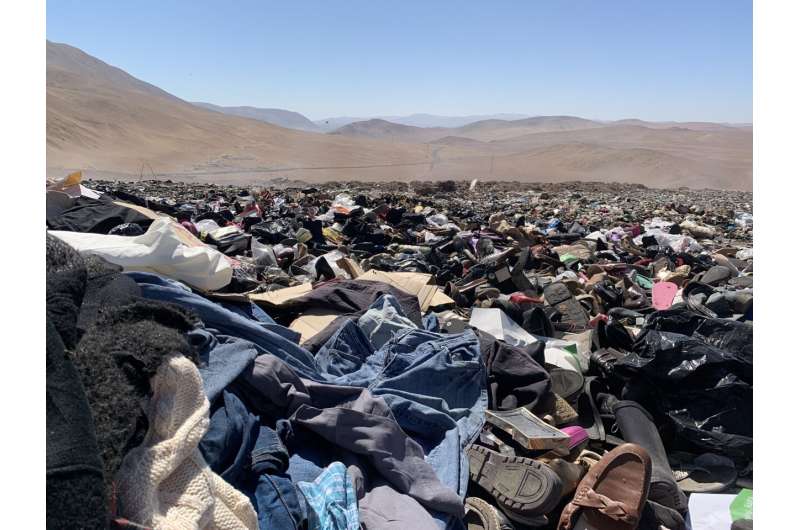This article has been reviewed according to Science X's editorial process and policies. Editors have highlighted the following attributes while ensuring the content's credibility:
fact-checked
peer-reviewed publication
trusted source
proofread
Study finds 90% of textile waste generated in Catalonia ends up in landfill or incinerators

A total of 90% of the municipal textile waste generated in Catalonia ends up in landfills or incinerators, according to a study by ICTA-UAB, which shows that only 10% of textile waste is collected separately. In the case of Catalonia, this percentage represented the management of 18,630 tons of clothing and other textile materials in 2020.
The report, published in Science of The Total Environment and carried out by researchers Gemma Morell, Laura Talens and Susana Toboso, sheds light on current textile waste disposal practices, both by the public and by authorized management entities, and accounts for their environmental impact.
The results show that, of the 10% that is collected separately through specialized containers located in the street, clean points, or door-to-door collection, 80% is recycled or reused mainly through sale in second-hand shops, flea markets or to other industries. Half is sold in Catalonia and Spain, while the remaining half is exported to countries in Asia, Africa, and Europe.
"Pakistan is the main destination for these clothes, followed by the United Arab Emirates, Switzerland and Cameroon. In 2020, Pakistan imported 3,500 tons of used clothing from Catalonia," explains Gemma Morell, researcher at ICTA-UAB and first author of the study.
The authors point out that the fact that 50% of the clothing suitable for reuse and recycling is exported to middle- or low-income countries, where its purpose is unknown, is evidence that "we are moving the problem to other places, without generating a sustainable solution," says Morell.
The study analyzes the behavior of citizens with regard to the separation of textile waste. Citizens associate these containers with charitable purposes and believe that they are only for clothes in good condition, so they take the clothes they consider to be in poorer condition to the green point or, above all, throw them in the gray container.
Citizens are not aware that all the clothes deposited in both the special containers and in the clean point go to the same place, to the authorized management companies, and that, probably, both the clothes in better condition and those in worse condition can be put to good use.
"It is true that a cotton T-shirt with a hole in it will not be sold in a second-hand shop, i.e., it will not be reused. But with this T-shirt you might be able to make a new garment out of recycled yarn, so it is recycled. And that's better than throwing the old T-shirt in the gray bin and having it go straight to the incinerator or landfill," Morrell says.
Regarding the environmental impact of textile waste, the research shows that separate collection emits 40% less CO2 eq than non-separate collection (directly to landfills and incinerators). The carbon footprint generated by one ton of textile waste managed by unseparated collection is 353 kg CO2 eq, which is much higher than the 207 kg CO2 eq generated by one ton of textile waste collected separately.
"The most sustainable option is to dispose of clothes in the appropriate containers. If we consider that each person in Catalonia consumes an average of 22 kg of clothes per year, we must bear in mind that, even in the ideal scenario of selective collection alone, disposing of these clothes has the same environmental impact per person as traveling seven times from Barcelona to New York in economy class," she explains.
The researchers therefore recall the need to reduce the mass production and consumption of clothing and to promote eco-design through the production of durable, high-quality items, prioritizing the use of single materials and recycled materials from the same textile industry. It is necessary to promote the second-hand market and the possibility of repairing garments to extend their useful life. "When a garment has to be discarded, the first thing to do is to reuse it or, if that is not possible, to recycle it, but always through processes that are carried out locally," she insists.
They also point out that a new European regulation is expected to come into force next year, which will make separate collection of textiles in municipalities compulsory. This will oblige institutions to facilitate separate collection and to improve the currently limited management capacity of authorized companies.
More information: Gemma Morell-Delgado et al, Revealing the management of municipal textile waste and citizen practices: The case of Catalonia, Science of The Total Environment (2023). DOI: 10.1016/j.scitotenv.2023.168093
Journal information: Science of the Total Environment
Provided by Autonomous University of Barcelona





















